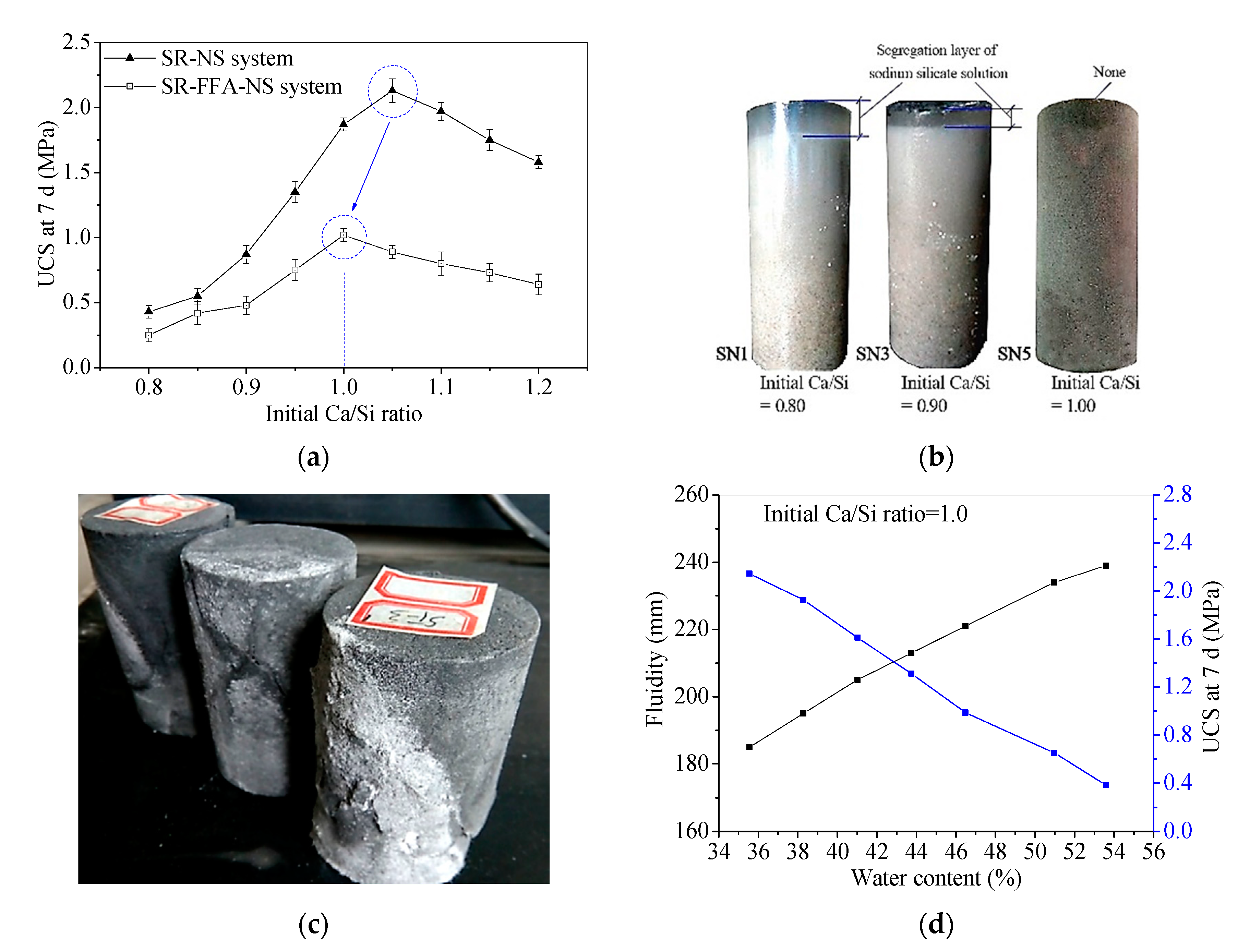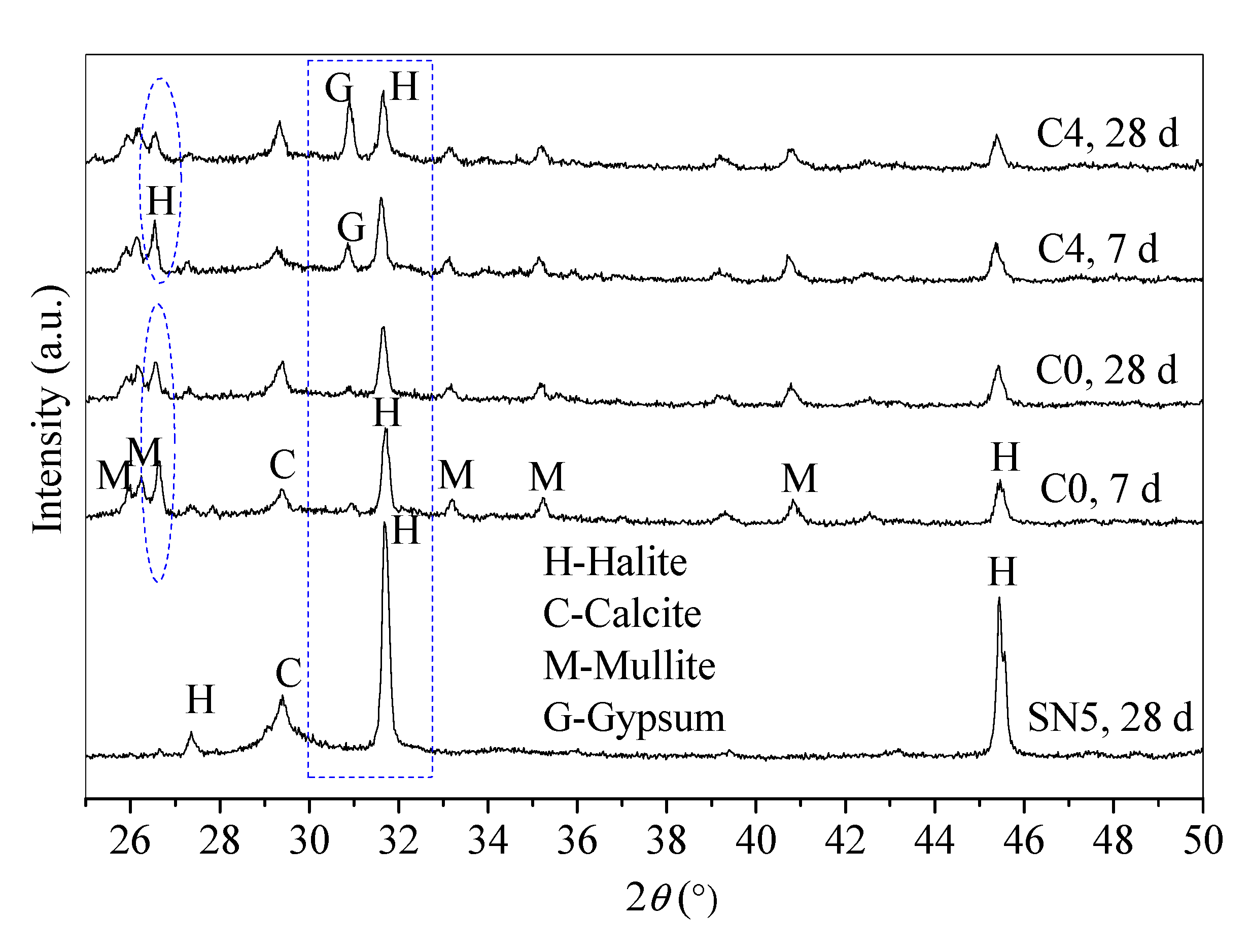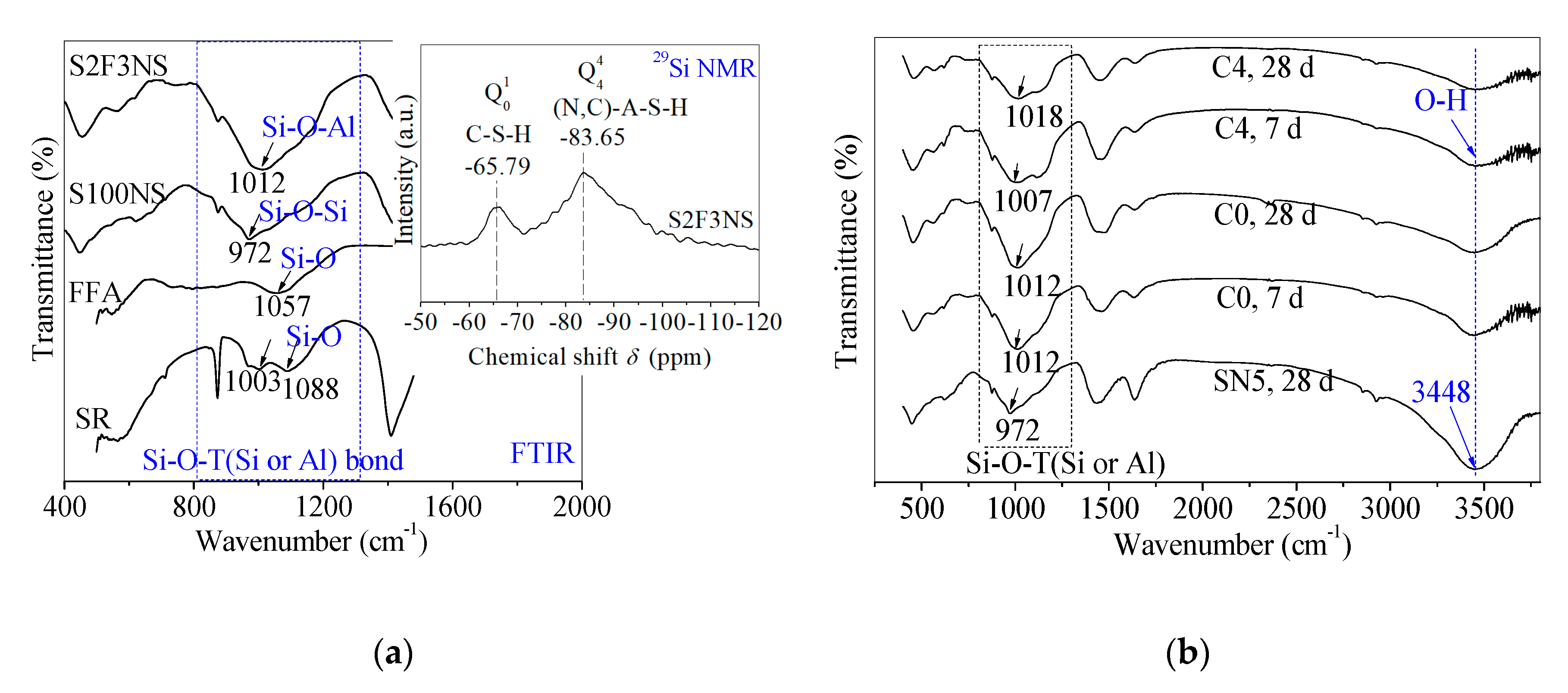Performance Optimization and Characterization of Soda Residue-Fly Ash Geopolymer Paste for Goaf Backfill: Beta-Hemihydrate Gypsum Alternative to Sodium Silicate
Abstract
1. Introduction
2. Materials and Methods
2.1. Materials
2.1.1. Fly Ash (FFA)
2.1.2. Soda Residue (SR)
2.1.3. Sodium Silicate (NS)
2.1.4. Beta-Hemihydrate Gypsum (BHG)
2.2. Preparation of Pastes
2.3. Testing Methods
2.3.1. Determination of Fresh and Hardened Properties
- (1)
- Measurement of fluidity and setting time
- (2)
- Measurement of stone rate and water-separation rate
- (3)
- Determination of unconfined compressive strength (UCS)
2.3.2. Micro-Characteristics of Hardened Backfill Pastes
3. Results and Discussion
3.1. Influence of Initial Ca/Si Ratios on Fluidity and 7 d Unconfined Compressive Strength (UCS)
→ (Na+, Ca2+) + n(OH)3-Si–O–Al−(OH)2–O–Si–(OH)3
→ (Na+, Ca2+)-[Si(OH)2–O-Al−(OH)2–O–Si–(OH)3–O–]n+ 4nH2O
3.2. The Proposed BHG Alternative to NS
3.3. Influence of BHG Alternative Ratios on Workability and UCS of Backfill Paste
3.4. Microstructural Characterization of Backfill Paste and Control
3.4.1. Micromorphology for the Product through Scanning Electron Microscopy (SEM)
3.4.2. Mineral Phase Analysis through X-Ray Diffraction (XRD)
3.4.3. Chemical Bonds Analysis for Gel Product through Fourier Transform Infrared (FTIR) Spectroscopy
4. Conclusions
- (1)
- The backfill pastes with initial Ca/Si ratio close to 1.0 possess the higher 7 d UCS and better solidification for the SR-NS system and SR-FFA-NS system.
- (2)
- The optimization method of BHG alternative to partial NS is proposed to improve the fresh and mechanical properties of geopolymer backfill pastes based on the reaction mechanism of SR-FFA-NS system.
- (3)
- The optimal backfill paste C4 is prepared with the mixing ratios (100 g SR, 150 g FFA, 16.24 g BHG, 146.16 g NS and 220 g water by mass), which possesses high workability (196–222 mm in fluidity), proper 28 d UCS (0.92 MPa), proper setting time (initial setting time of 1375 min and final setting time of 1683 min) as well as high stone ratio (98.6%). The optimal paste is composed of 10% BHG alternative ratios to NS as well as initial Ca/Si ratio 1.05.
- (4)
- The gel products of paste C4 are determined as the coexistence of C-S-H gel, (N,C)-A-S-H gel and CaSO4·2H2O. The hydration of CaSO4·0.5H2O in BHG and the formed C-S-H gel from the reaction of SR and NS determine the workability and UCS at the early term. The (N,C)-A-S-H gels formed from the alkali-activated FFA promote long-term strength development.
Author Contributions
Funding
Conflicts of Interest
References
- Tho-In, T.; Sata, V.; Boonserm, K.; Chindaprasirt, P. Compressive strength and microstructure analysis of geopolymer paste using waste glass powder and fly ash. J. Clean. Prod. 2018, 172, 2892–2898. [Google Scholar] [CrossRef]
- Zhuang, X.Y.; Chen, L.; Komarneni, S.; Zhou, C.H.; Tong, D.S.; Yang, H.M.; Yu, W.H.; Wang, H. Fly ash-based geopolymer: Clean production, properties and applications. J. Clean. Prod. 2016, 125, 253–267. [Google Scholar] [CrossRef]
- Zhao, X.H.; Liu, C.Y.; Wang, L.; Zuo, L.M.; Zhu, Q.; Ma, W. Physical and mechanical properties and micro characteristics of fly ash-based geopolymers incorporating soda residue. Cem. Concr. Compos. 2019, 98, 125–136. [Google Scholar] [CrossRef]
- Zhao, X.; Liu, C.; Zuo, L.; Zhu, Q.; Ma, W.; Liu, Y. Preparation and characterization of press-formed fly ash cement incorporating soda residue. Mater. Lett. 2020, 259, 126852. [Google Scholar] [CrossRef]
- Zhang, J.; Tan, H.; He, X.; Yang, W.; Deng, X. Utilization of carbide slag-granulated blast furnace slag system by wet grinding as low carbon cementitious materials. Constr. Build. Mater. 2020, 249, 118763. [Google Scholar] [CrossRef]
- Castel, A.; Foster, S.J. Bond strength between blended slag and Class F fly ash geopolymer concrete with steel reinforcement. Cem. Concr. Res. 2015, 72, 48–53. [Google Scholar] [CrossRef]
- Sarker, P.K.; McBeath, S. Fire endurance of steel reinforced fly ash geopolymer concrete elements. Constr. Build. Mater. 2015, 90, 91–98. [Google Scholar] [CrossRef]
- Shi, C.J.; Jimenez, A.F.; Palomo, A. New cements for the 21st century: The pursuit of an alternative to Portland cement. Cem. Concr. Res. 2011, 41, 750–763. [Google Scholar] [CrossRef]
- Nematollahi, B.; Sanjayan, J.; Shaikh, F.U.A. Synthesis of heat and ambient cured one-part geopolymer mixes with different grades of sodium silicate. Ceram. Int. 2015, 41, 5696–5704. [Google Scholar] [CrossRef]
- Assi, L.; Carter, K.; Deaver, E.; Anay, R.; Ziehl, P. Sustainable concrete: Building a greener future. J. Clean. Prod. 2018, 198, 1641–1651. [Google Scholar] [CrossRef]
- Saha, S.; Rajasekaran, C. Enhancement of the properties of fly ash based geopolymer paste by incorporating ground granulated blast furnace slag. Constr. Build. Mater. 2017, 146, 615–620. [Google Scholar] [CrossRef]
- Bernal, S.A.; de Gutierrez, R.M.; Provis, J.L.; Rose, V. Effect of silicate modulus and metakaolin incorporation on the carbonation of alkali silicate-activated slags. Cem. Concr. Res. 2010, 40, 898–907. [Google Scholar] [CrossRef]
- Pasupathy, K.; Berndt, M.; Sanjayan, J.; Rajeev, P.; Cheema, D.S. Durability of low-calcium fly ash based geopolymer concrete culvert in a saline environment. Cem. Concr. Res. 2017, 100, 297–310. [Google Scholar] [CrossRef]
- National Development and Reform Commission of China. Implementing Scheme of Mainly Solid Waste Utilization (Beijing); Fly ash utilization in China; National Development and Reform Commission: Beijing, China, 2011; Volume 2, pp. 23–73. (In Chinese)
- Shang, J.; Dai, J.G.; Zhao, T.J.; Guo, S.Y.; Zhang, P.; Mu, B. Alternation of traditional cement mortars using fly ash-based geopolymer mortars modified by slag. J. Clean. Prod. 2018, 203, 746–756. [Google Scholar] [CrossRef]
- Liu, Y.L.; Wang, Y.S.; Fang, G.H.; Alrefaei, Y.; Dong, B.Q.; Xing, F. A preliminary study on capsule-based self-healing grouting materials for grouted splice sleeve connection. Constr. Build. Mater. 2018, 170, 418–423. [Google Scholar] [CrossRef]
- Chindaprasirt, P.; Rattanasak, U. Characterization of the high-calcium fly ash geopolymer mortar with hot-weather curing systems for sustainable application. Adv. Powder Technol. 2017, 28, 2317–2324. [Google Scholar] [CrossRef]
- Somna, K.; Jaturapitakkul, C.; Kajitvichyanukul, P.; Chindaprasirt, P. NaOH-activated ground fly ash geopolymer cured at ambient temperature. Fuel 2011, 90, 2118–2124. [Google Scholar] [CrossRef]
- Li, H.; Wu, A.X.; Wang, H.J. Evaluation of short-term strength development of cemented backfill with varying sulphide contents and the use of additives. J. Environ. Manag. 2019, 239, 279–286. [Google Scholar] [CrossRef]
- Hadi, M.N.S.; Al-Azzawi, M.; Yu, T. Effects of fly ash characteristics and alkaline activator components on compressive strength of fly ash-based geopolymer mortar. Constr. Build. Mater. 2018, 175, 41–54. [Google Scholar] [CrossRef]
- Sun, Q.; Tian, S.; Sun, Q.W.; Li, B.; Cai, C.; Xia, Y.J.; Wei, X.; Mu, Q.W. Preparation and microstructure of fly ash geopolymer paste backfill material. J. Clean. Prod. 2019, 225, 376–390. [Google Scholar] [CrossRef]
- Zhou, B.; Wang, L.; Ma, G.; Zhao, X.; Zhao, X. Preparation and properties of bio-geopolymer composites with waste cotton stalk materials. J. Clean. Prod. 2020, 245, 118842. [Google Scholar] [CrossRef]
- Zhao, X.H.; Liu, C.Y.; Zuo, L.M.; Wang, L.; Zhu, Q.; Wang, M.K. Investigation into the effect of calcium on the existence form of geopolymerized gel product of fly ash based geopolymers. Cem. Concr. Compos. 2019, 103, 279–292. [Google Scholar] [CrossRef]
- Zhao, X.; Liu, C.; Zuo, L.; Wang, L.; Zhu, Q.; Liu, Y.; Zhou, B. Synthesis and characterization of fly ash geopolymer paste for goaf backfill: Reuse of soda residue. J. Clean. Prod. 2020, 260, 121045. [Google Scholar] [CrossRef]
- Yu, S.J.; Bi, W.Y.; Zheng, L.G.; Duan, Y.L. Impact of Cl- on environment when industrial soda residue is applied in highway project. Prog. Environ. Sci. Technol. 2007, I, 361–364. [Google Scholar]
- Gorhan, G.; Kurklu, G. The influence of the NaOH solution on the properties of the fly ash-based geopolymer mortar cured at different temperatures. Compos. Part B Eng. 2014, 58, 371–377. [Google Scholar] [CrossRef]
- Pavithra, P.; Reddy, M.S.; Dinakar, P.; Rao, B.H.; Satpathy, B.K.; Mohanty, A.N. A mix design procedure for geopolymer concrete with fly ash. J. Clean. Prod. 2016, 133, 117–125. [Google Scholar] [CrossRef]
- Ouattara, D.; Belem, T.; Mbonimpa, M.; Yahia, A. Effect of superplasticizers on the consistency and unconfined compressive strength of cemented paste backfills. Constr. Build. Mater. 2018, 181, 59–72. [Google Scholar] [CrossRef]
- Yousefi Oderji, S.; Chen, B.; Ahmad, M.R.; Shah, S.F.A. Fresh and hardened properties of one-part fly ash-based geopolymer binders cured at room temperature: Effect of slag and alkali activators. J. Clean. Prod. 2019, 225, 1–10. [Google Scholar] [CrossRef]
- Niroshan, N.; Sivakugan, N.; Veenstra, R.L. Laboratory study on strength development in cemented paste backfills. J. Mater. Civil Eng. 2017, 29. [Google Scholar] [CrossRef]
- Fahim Huseien, G.; Mirza, J.; Ismail, M.; Ghoshal, S.K.; Abdulameer Hussein, A. Geopolymer mortars as sustainable repair material: A comprehensive review. Renew. Sust. Energ. Rev. 2017, 80, 54–74. [Google Scholar] [CrossRef]
- Swanepoel, J.C.; Strydom, C.A. Utilisation of fly ash in a geopolymeric material. Appl. Geochem. 2002, 17, 1143–1148. [Google Scholar] [CrossRef]
- Li, B.J.; Li, G.Z. Study on mechanical properties of soda residue/fly ash composite cementitious material. Adv. Mater. Res. Switz. 2011, 194–196, 1026–1029. [Google Scholar] [CrossRef]
- Sun, Q. Experimental Study on the Properties of Fly Ash-Based Grouting Backfill Materials. Master‘s Thesis, Kunming University of Science and Technology, Kunming, China, 2009. (In Chinese). [Google Scholar]
- Ye, N.; Yang, J.K.; Ke, X.Y.; Zhu, J.; Li, Y.L.; Xiang, C.; Wang, H.B.; Li, L.; Xiao, B. Synthesis and characterization of geopolymer from bayer red mud with thermal pretreatment. J. Am. Ceram. Soc. 2014, 97, 1652–1660. [Google Scholar] [CrossRef]
- Lin, Y.; Xu, D.; Zhao, X. Effect of soda residue addition and its chemical composition on physical properties and hydration products of soda residue-activated slag cementitious materials. Materials 2020, 13, 1789. [Google Scholar] [CrossRef] [PubMed]
- Garcia-Lodeiro, I.; Palomo, A.; Fernandez-Jimenez, A.; Macphee, D.E. Compatibility studies between N-A-S-H and C-A-S-H gels. Study in the ternary diagram Na2O-CaO-Al2O3-SiO2-H2O. Cem. Concr. Res. 2011, 41, 923–931. [Google Scholar] [CrossRef]






| SR | Percentage (wt.%) | FFA | Percentage (wt.%) |
|---|---|---|---|
| CaCO3 | 64.0 | SiO2 | 48.37 |
| Ca(OH)2 | 10.0 | Al2O3 | 28.90 |
| CaCl2 | 6.0 | Fe2O3 | 7.00 |
| NaCl | 4.0 | CaO | 4.47 |
| CaSO4 | 3.0 | FeO | 2.31 |
| SiO2 | 3.0 | MgO | 1.30 |
| Al2O3 | 2.0 | LOI 1 | 5.95 |
| Acid insoluble | 8.0 | Others | 1.70 |
| Materials | Amount Passing #325 Sieve | Specific Gravity | Specific Surface Area (m2/kg) | pH Value at w100 2 |
|---|---|---|---|---|
| FFA | 77% | 2.43 | 509 | 8.50 |
| SR | — | 2.35 | — | 8.35 |
| No. | SR (g) | NS (g) | Water (g) | FFA (g) | Initial Ca/Si Ratio 3 |
|---|---|---|---|---|---|
| SN1 | 99.53 | 150.71 | 120.0 | 0 | 0.80 |
| SN2 | 105.75 | 150.71 | 120.0 | 0 | 0.85 |
| SN3 | 111.97 | 150.71 | 120.0 | 0 | 0.90 |
| SN4 | 118.49 | 150.71 | 120.0 | 0 | 0.95 |
| SN5 | 125.00 | 150.71 | 120.0 | 0 | 1.00 |
| SN6 | 130.93 | 150.71 | 120.0 | 0 | 1.05 |
| SN7 | 136.85 | 150.71 | 120.0 | 0 | 1.10 |
| SN8 | 143.08 | 150.71 | 120.0 | 0 | 1.15 |
| SN9 | 149.30 | 150.71 | 120.0 | 0 | 1.20 |
| SNF1 | 99.53 | 150.71 | 180.0 | 90 | 0.80 |
| SNF2 | 105.75 | 150.71 | 180.0 | 90 | 0.85 |
| SNF3 | 111.97 | 150.71 | 180.0 | 90 | 0.90 |
| SNF4 | 118.49 | 150.71 | 180.0 | 90 | 0.95 |
| SNF5 | 125.00 | 150.71 | 180.0 | 90 | 1.00 |
| SNF6 | 130.93 | 150.71 | 180.0 | 90 | 1.05 |
| SNF7 | 136.85 | 150.71 | 180.0 | 90 | 1.10 |
| SNF8 | 143.08 | 150.71 | 180.0 | 90 | 1.15 |
| SNF9 | 149.30 | 150.71 | 180.0 | 90 | 1.20 |
| No. | SR (g) | NS (g) | Water (g) | FFA (g) | Initial Ca/Si Ratio | Water Content (%) |
|---|---|---|---|---|---|---|
| W1 | 125.00 | 150.71 | 130.0 | 90 | 1.00 | 35.55 |
| W2 | 125.00 | 150.71 | 140.0 | 90 | 1.00 | 38.28 |
| W3 | 125.00 | 150.71 | 150.0 | 90 | 1.00 | 41.02 |
| W4 | 125.00 | 150.71 | 160.0 | 90 | 1.00 | 43.75 |
| W5 | 125.00 | 150.71 | 170.0 | 90 | 1.00 | 46.48 |
| W6 | 125.00 | 150.71 | 186.4 | 90 | 1.00 | 50.97 |
| W7 | 125.00 | 150.71 | 196.0 | 90 | 1.00 | 53.59 |
| No. | SR (g) | FFA (g) | BHG (g) | NS (g) | Alternative Ratio (%) | Water (g) | Initial Ca/Si Ratio |
|---|---|---|---|---|---|---|---|
| C0 | 100 | 150 | 0.00 | 162.40 | 0.0 | 220 | 0.75 |
| C1 | 100 | 150 | 4.06 | 158.34 | 2.5 | 220 | 0.82 |
| C2 | 100 | 150 | 8.12 | 154.28 | 5.0 | 220 | 0.89 |
| C3 | 100 | 150 | 12.18 | 150.22 | 7.5 | 220 | 0.97 |
| C4 | 100 | 150 | 16.24 | 146.16 | 10.0 | 220 | 1.05 |
| C5 | 100 | 150 | 20.30 | 142.10 | 12.5 | 220 | 1.13 |
| C6 | 100 | 150 | 24.36 | 138.04 | 15.0 | 220 | 1.22 |
| C7 | 100 | 150 | 28.42 | 133.98 | 17.5 | 220 | 1.32 |
| C8 | 100 | 150 | 32.48 | 129.92 | 20.0 | 220 | 1.42 |
Publisher’s Note: MDPI stays neutral with regard to jurisdictional claims in published maps and institutional affiliations. |
© 2020 by the authors. Licensee MDPI, Basel, Switzerland. This article is an open access article distributed under the terms and conditions of the Creative Commons Attribution (CC BY) license (http://creativecommons.org/licenses/by/4.0/).
Share and Cite
Wang, H.; Zhao, X.; Zhou, B.; Lin, Y.; Gao, H. Performance Optimization and Characterization of Soda Residue-Fly Ash Geopolymer Paste for Goaf Backfill: Beta-Hemihydrate Gypsum Alternative to Sodium Silicate. Materials 2020, 13, 5604. https://doi.org/10.3390/ma13245604
Wang H, Zhao X, Zhou B, Lin Y, Gao H. Performance Optimization and Characterization of Soda Residue-Fly Ash Geopolymer Paste for Goaf Backfill: Beta-Hemihydrate Gypsum Alternative to Sodium Silicate. Materials. 2020; 13(24):5604. https://doi.org/10.3390/ma13245604
Chicago/Turabian StyleWang, Haoyu, Xianhui Zhao, Boyu Zhou, Yonghui Lin, and Han Gao. 2020. "Performance Optimization and Characterization of Soda Residue-Fly Ash Geopolymer Paste for Goaf Backfill: Beta-Hemihydrate Gypsum Alternative to Sodium Silicate" Materials 13, no. 24: 5604. https://doi.org/10.3390/ma13245604
APA StyleWang, H., Zhao, X., Zhou, B., Lin, Y., & Gao, H. (2020). Performance Optimization and Characterization of Soda Residue-Fly Ash Geopolymer Paste for Goaf Backfill: Beta-Hemihydrate Gypsum Alternative to Sodium Silicate. Materials, 13(24), 5604. https://doi.org/10.3390/ma13245604








